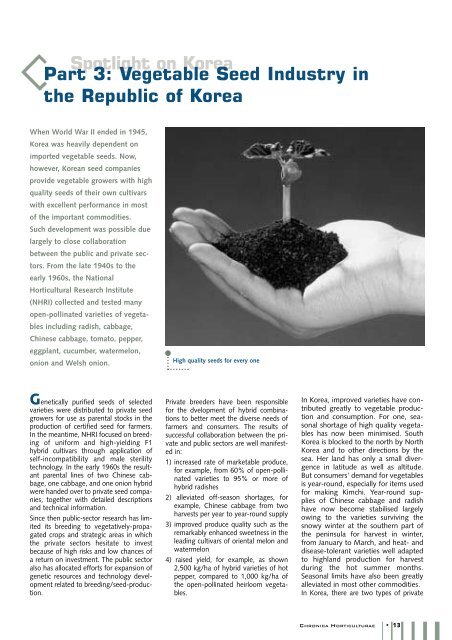Acta Horticulturae
Acta Horticulturae
Acta Horticulturae
You also want an ePaper? Increase the reach of your titles
YUMPU automatically turns print PDFs into web optimized ePapers that Google loves.
Spotlight on Korea<br />
Part 3: Vegetable Seed Industry in<br />
the Republic of Korea<br />
When World War II ended in 1945,<br />
Korea was heavily dependent on<br />
imported vegetable seeds. Now,<br />
however, Korean seed companies<br />
provide vegetable growers with high<br />
quality seeds of their own cultivars<br />
with excellent performance in most<br />
of the important commodities.<br />
Such development was possible due<br />
largely to close collaboration<br />
between the public and private sectors.<br />
From the late 1940s to the<br />
early 1960s, the National<br />
Horticultural Research Institute<br />
(NHRI) collected and tested many<br />
open-pollinated varieties of vegetables<br />
including radish, cabbage,<br />
Chinese cabbage, tomato, pepper,<br />
eggplant, cucumber, watermelon,<br />
onion and Welsh onion.<br />
Genetically purified seeds of selected<br />
varieties were distributed to private seed<br />
growers for use as parental stocks in the<br />
production of certified seed for farmers.<br />
In the meantime, NHRI focused on breeding<br />
of uniform and high-yielding F1<br />
hybrid cultivars through application of<br />
self-incompatibility and male sterility<br />
technology. In the early 1960s the resultant<br />
parental lines of two Chinese cabbage,<br />
one cabbage, and one onion hybrid<br />
were handed over to private seed companies,<br />
together with detailed descriptions<br />
and technical information.<br />
Since then public-sector research has limited<br />
its breeding to vegetatively-propagated<br />
crops and strategic areas in which<br />
the private sectors hesitate to invest<br />
because of high risks and low chances of<br />
a return on investment. The public sector<br />
also has allocated efforts for expansion of<br />
genetic resources and technology development<br />
related to breeding/seed-production.<br />
High quality seeds for every one<br />
Private breeders have been responsible<br />
for the dvelopment of hybrid combinations<br />
to better meet the diverse needs of<br />
farmers and consumers. The results of<br />
successful collaboration between the private<br />
and public sectors are well manifested<br />
in:<br />
1) increased rate of marketable produce,<br />
for example, from 60% of open-pollinated<br />
varieties to 95% or more of<br />
hybrid radishes<br />
2) alleviated off-season shortages, for<br />
example, Chinese cabbage from two<br />
harvests per year to year-round supply<br />
3) improved produce quality such as the<br />
remarkably enhanced sweetness in the<br />
leading cultivars of oriental melon and<br />
watermelon<br />
4) raised yield, for example, as shown<br />
2,500 kg/ha of hybrid varieties of hot<br />
pepper, compared to 1,000 kg/ha of<br />
the open-pollinated heirloom vegetables.<br />
In Korea, improved varieties have contributed<br />
greatly to vegetable production<br />
and consumption. For one, seasonal<br />
shortage of high quality vegetables<br />
has now been minimised. South<br />
Korea is blocked to the north by North<br />
Korea and to other directions by the<br />
sea. Her land has only a small divergence<br />
in latitude as well as altitude.<br />
But consumers’ demand for vegetables<br />
is year-round, especially for items used<br />
for making Kimchi. Year-round supplies<br />
of Chinese cabbage and radish<br />
have now become stabilised largely<br />
owing to the varieties surviving the<br />
snowy winter at the southern part of<br />
the peninsula for harvest in winter,<br />
from January to March, and heat- and<br />
disease-tolerant varieties well adapted<br />
to highland production for harvest<br />
during the hot summer months.<br />
Seasonal limits have also been greatly<br />
alleviated in most other commodities.<br />
In Korea, there are two types of private<br />
CHRONICA HORTICULTURAE • 13

















